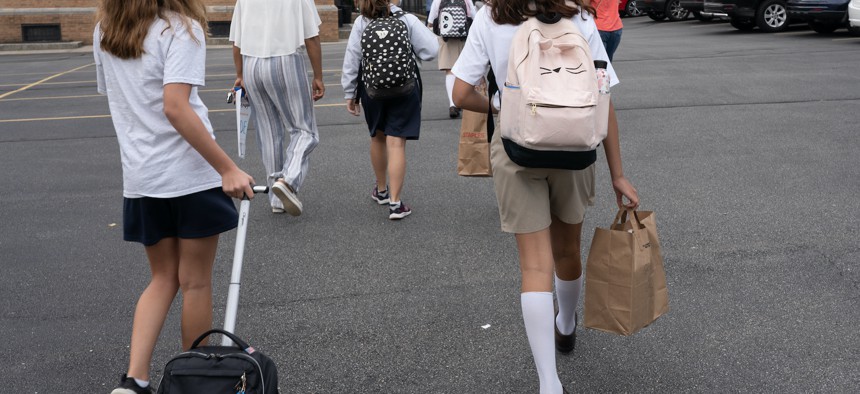Education
Why NYC Asian American students are opting for remote learning
Families in multigenerational homes and fears of the coronavirus drive choice to stay in virtual classrooms.

Students walking in to the first day of school at St. Francis of Assisi Catholic Academyon September 9, 2020. Ron Adar/Shutterstock
As New York City’s school reopening plans are largely delayed once again, families are struggling with whether to attempt a mix of in-person and remote learning, or to send their children only to virtual classes. For Asian American New Yorkers, the answer more often seems to be continued remote learning.
More than half of Asian American families with children in the city’s public schools have requested remote learning for the upcoming school year, choosing that at a greater rate than families of any other demographic. One in four of the students who have been asking for remote learning are Asian American, while Asian Americans make up about 18% of the overall school population. Asian and Pacific Islander students also make up the greatest share of the population of the three school districts that have seen the most requests for virtual learning, according to recently released data from the New York City Department of Education. Close to 60% of Asian American students have requested remote learning, compared with approximately 40% of Black and Hispanic students.
Vanessa Leung, co-executive director of the Coalition for Asian American Children & Families, said one common factor they’ve heard from their member organizations is that many Asian American parents opting out of blended learning are in multigenerational homes. In addition to wanting to avoid spreading the coronavirus to vulnerable older relatives, this also means families are more likely to have built-in options for child care.
Another understated factor is ongoing concerns about COVID-19 and the impact it has had on Asian American New Yorkers, said Jiyoon Mary Chung, interim executive director of Apex for Youth, an educational nonprofit serving Asian American and immigrant youth. While data from the New York City Department of Health shows the Asian American community has seen the fewest cases of COVID-19 compared with any other demographic, figures published last month by the Centers for Disease Control and Prevention show that they were the second hardest-hit community in the city when evaluated by the increase in death tolls. This data evaluated the increase of death overall this year – whether explicitly from COVID or another reason – compared with before the pandemic. It shows that deaths spiked among Asian Americans in the city by 112%. Asian Americans may be getting tested less frequently than other groups, or it may be an indicator that Asian Americans were more likely to avoid medical treatment for other conditions in order to avoid COVID exposure. In comparison, white New Yorkers saw a spike of 50%.
Chinese American New Yorkers are also particularly cautious about infection because they’ve been aware of the coronavirus’s threat for longer than many other communities. “They have family and relatives in China and have been hearing about this for months,” Chung said.
The Chinese-American Planning Council surveyed 700 families with children between the ages of 1 to 12 from early July to August on their school plans. Families were evenly split between preferring full in-person learning five days a week, a hybrid model and full remote learning. Many respondents preferring in-person learning were essential workers, often the household’s lone breadwinner, who couldn’t leave their kids at home, said Mary Cheng, the organization’s director of childhood development services, where those who worked from home were more likely to go remote.
“One of the things we’ve been constantly asking the (Department of Education) for is actually better disaggregation of the data,” Leung said, in order to get a better sense of what challenges ethnic communities are facing throughout the city. Insufficient outreach and communication from schools with parents who aren’t proficient in English, particularly immigrants, also remains a continued challenge for some families going into the school year.
That communication is particularly important given how confusing the reopening process has been overall. New York City is now delayed reopening for most in-person classes a second time, and news is emerging that in-person classes at several schools will still solely be online because of staffing shortages. Even before this recent news emerged, the uncertainty has driven a spike in families going remote. As of Monday, 42% of public school students requested remote learning compared with 26% on Aug. 10.

NEXT STORY: New report lays out state budget actions for climate change

